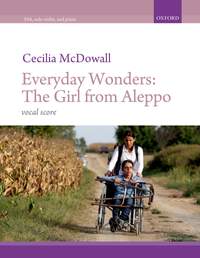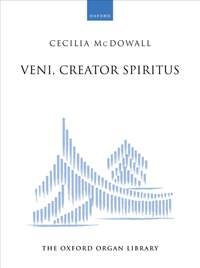Interview,
Cecilia McDowall on her Da Vinci Requiem and Seventy Degrees below Zero

I spoke to Cecilia to talk about how these works took shape - a complicated process taking in the initial forming of the idea of a work, the selection and refining of texts, and of course the composition of the music itself.
Variants of the Requiem Mass are now so widespread that they’re almost a genre of their own; but devoting one to a specific individual is rather different. What was it about da Vinci that led you to conceive of this unique work?
Two things, really. The commission came from Wimbledon Choral and when they asked what I’d like to write I said a Requiem, something I’d had in mind for a while. And as we discussed it, other things emerged – such as the date of the performance being close to the date Leonardo da Vinci died, five hundred years previously.
Leonardo da Vinci’s notebooks were familiar territory to me. When my parents married in the 1940s, my mother gave my father a copy of the notebooks as a wedding present. They were always in the house. So I decided to look at Leonardo’s philosophical ideas and see if they could tie up with the Requiem Mass in some way.
The other thing I felt was that situations are different now for many people, in terms of belief. A Requiem perhaps doesn’t have quite the same pull or urgency for the listeners these days, as it once did so I was keen to introduce a humanistic element to the Mass.
You’re no stranger to setting existing texts, whether contemporary or centuries-old, but here you’re taking on part of the lyricist’s role yourself – selecting passages from da Vinci’s writings to counterpoint the Requiem text. How did you go about deciding which words would fit best?
I started
work by deciding on the structure of the Mass. The Da Vinci Requiem is a
seven-section work, though
there are around twelve settable sections available in the Requiem liturgy. So it was a matter of going through the text in
Latin, selecting the parts of the Mass I felt would be most appropriate to work
alongside Leonardo’s philosophical writings.
In the case of the Agnus Dei I found something in
Leonardo’s Bestiary which related to the ‘humility’ of the lamb. The last
movement, Lux Aeterna,
binds Leonardo’s visions of flight to the concept of Light Eternal. Leonardo says,
‘When once you have tasted flight, you will forever walk the earth with your
eyes turned skyward’ which works well for the text of the final movement of a
Requiem.
One movement which gave me pause was the Dies Irae. I felt with so much awfulness unfolding in the world today it might be best to avoid a Day of Wrath approach! By chance I came across a beautiful poem by Dante Gabriel Rossetti, which he wrote in 1848 while seated in front of Leonardo’s Virgin of the Rocks in what is now the National Gallery. It’s a dark poem and refers to the ‘shadow of death’ which felt would more in keeping in tone and mood for that part of the Requiem. Not so much apocalyptic hellfire and brimstone; just darker and perhaps more subtle.

Where the Da Vinci Requiem is uplifting and optimistic, Seventy Degrees below Zero is concerned with the pitiless cold and “sublime inhumanity” of the South Pole and the doomed Scott Expedition. Is this work also a kind of Requiem, in its way?
Yes, in a sense. When the Scott Polar Research Institute invited me to write about Captain Scott, to mark the centenary of his death, I was shown the letter he addressed “To my widow” – it is as if he’s writing his own obituary and it’s heart-breaking to read it. That was my starting point. But I also felt it would be really interesting to bring some of the science of the Antarctic exploration into the work, so that it might broaden the whole concept.
When you put pen to paper, how different is the
process of setting contemporary lyrics (for instance, Séan Street’s paean to
intricate scientific equipment), compared to ritualised religious texts that
choral singers know inside-out?
Séan Street was very clever in the way he gathered the scientific material for Seventy Degrees below Zero and I found the different scientific words great fun to set, such as ‘katabatic’ or ‘spirometer’! I always hope that maybe some of the information in a new work might be of interest to the performer and the listener, even stimulate a desire to explore ideas further.

Séan and I talked a lot about how to approach the work together. We had the letter as our starting point but we needed to contextualise it. The work opens with a spoken statement from Scott defining the expedition’s exact location. Séan’s elegant poetry takes us to the South Pole, followed by disappointment after realising Amundsen had beaten the expedition to it. The second movement, The Ice Tree, casts a glacial light over the passage of time, as if looking backwards through the telescopic lens of the ice core. A moment of reflection. I was invited to SPRI (Scott Polar Research Institute) to see the bulky clothes, heavy equipment and cumbersome sledges … a fascinating introduction to what these brave men had to handle. The weight and the laboursome ‘dragging’ of the sledges gave me some inspiration for a grating downward-moving motif in this movement.
As someone with a long and distinguished career
as a choral composer, what do you think the future holds for choral music? Are
there any new directions or trends that you see emerging that might shape the
next generation?
It’s
difficult to say. Things are changing rapidly and perhaps most obviously in
terms of gender equality. And what a tumultuous time it has been recently,
underlined by the appalling decision made by the BBC to disband the BBC Singers
who, many more people will now know, are simply exceptional. The BBC Singers
has trailblazed a commitment to 50/50 gender balance for some time now.
As for the
way things are going more generally now I can’t assess, in any meaningful way, the
direction of travel. All I can do is draw on my own approach, what inspires me,
what interests me. In the field of secular music I usually write ‘about’
something and I’m always keen to make a connection with the listener and
performer if I can. I like to think of what is happening now, something new,
something relevant and perhaps something we should all be thinking more about. The Henley Choral Society
commissioned a work from me recently. The original suggestion was to write
about the river/water in some way. It was a good starting point which led me to
think more about water, ice and the Greenland melting ice sheet. I asked the
poet, Kate Wakeling, if she would write poems for this work and she very
cleverly found a contemporaneous account of a Frost Fair in the seventeenth
century and extended the work by exploring information from Josh Willis, a climate scientist who said,
“when the ocean speaks, the ice listens”. The work is called ‘The Ice is Listening’.
I felt this
was a way of introducing information to people that might strike home or
encourage more investigation. Perhaps singing about something difficult can
bring things closer to home for some people.
And you could reach people who might not
otherwise encounter some of these concepts…
Yes – as with a piece from a few years ago, The
Girl from Aleppo. This is a cantata about Nujeen Mustafa, a Kurdish teenager with cerebral
palsy, who made an astonishing journey, travelling three and a half thousand miles in a
wheelchair, pushed by her
sister, to escape the Syrian Civil War. It was commissioned by the
National Children’s Choir of Great Britain. I felt it was a great way to introduce the concept of
‘children in conflict’ through such a compassionate human story to the young
singers. The children became very involved in Nujeen’s story, asking many
questions about her and about the difficulties of having to leave one’s home
country.
This reminds me of another piece from longer ago,
commemorating a photograph that had been instrumental in an important discovery
in genetics – it sounds like this approach is one you’ve been employing for
some time?
Photo 51; the crystallographer, Rosalind Franklin, discovered the double helix in her x-ray, called Photo 51. She shared the information with Crick and Watson who earned a Nobel prize for the discovery of DNA. Rosalind Franklin died before Crick and Watson were awarded the prize.
And I have written other works about remarkable women. ‘Standing as I do before God’ commemorates Nurse Edith Cavell, who sheltered Allied soldiers in her hospital when the Germans occupied Belgium in the First World War. She carefully found ways to help return around 200 soldiers to Britain but perhaps due to the letters of gratitude from those she had helped she was discovered and arrested. In October 1915 she was executed for treason.
And I have written a work for cello and mixed chorus, ‘Night Flight’, about
another remarkable woman, Harriet Quimby – an American aviatrix who flew across
the English Channel in 1912 in just under an hour in the fog. Few people have
ever heard of her, and her astonishing achievement, because on that same
night the Titanic sank!
My latest piece is a rather heart-breaking one, actually; it will be premiered on May 18th in St Paul's, Covent Garden. It is a commission from Syracuse University in New York to mark and commemorate the 35 Syracuse students who died in the Lockerbie bombing in 1988. A most moving aspect of this is that one of the students who died, Nicholas Vrenios, had written a poem, just a few months before which was eerily prescient in its imagery: “Such a brilliant ball of fire. It glowed with rainbow colours as it plumaged to the earth”. Quite extraordinary. I've set his text, ‘Such Splendor’, in this new piece.
This significant work from Cecilia McDowall presents an imaginative pairing of the Latin Requiem text and extracts from the Notebooks of Leonardo da Vinci, with contrasting solo and chorus movements creating an effective dramatization.
Available Format: Sheet Music
Everyday Wonders: The Girl from Aleppo tells the extraordinary story of Nujeen Mustafa, a Kurdish teenager with cerebral palsy forced by war to flee her home and embark on an arduous journey to Europe with her sister.
Available Format: Sheet Music
The initial marking 'Sparkling' is a good description of this piece's effervescent Toccata-like figurations and striking harmonies. The plainsong theme appears in longer note values either in the pedal or at the top of the texture. Imaginative use of the organ creates an exciting atmosphere as the piece reaches a powerful conclusion.
Available Format: Sheet Music






